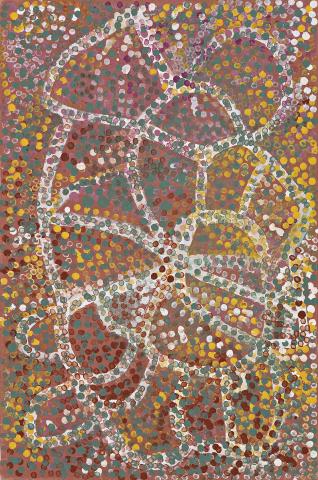EMU DREAMING, 1991
EMILY KAME KNGWARREYE
synthetic polymer paint on canvas
91.5 x 60.0 cm
inscribed verso: artist’s name and Mulga Bore artists cat. 23-1191
Commissioned by Rodney Gooch,
Mulga Bore Artists, Northern Territory
Dreamtime Gallery, Perth
Private collection, Sydney, acquired from the above in 1992
One Dreaming (Yam Story), 1991, in the Holmes à Court Collection, illus. in Carrigan, B. (ed.), Utopia: Ancient Cultures, New Forms, The Holmes à Court Collection in association with the Art Gallery of Western Australia, Perth, 1999, p. 42
Utopia's modern-day art movement started in 1977 when a batik-making fabric workshop evolved as an extension to a women's adult education literacy course. Kngwarreye was a founding member of the Women's Batik Group. Encouraged by Jennifer Green and Julia Murray who taught Batik techniques to the women, the batiks produced were immediately recognised as containing a freshness and expressive vitality that had not been seen before in aboriginal art production. In this early communal project no one artist was singled out above the rest. All were encouraged equally to produce work.
Over the following years, the Holmes à Court Collection sponsored a series of similar projects which launched the Utopia artists out to an awaiting public. Kngwarreye's paintings began to attract attention partly due to the prominence gained by the reproduction of her first canvas, Emu Woman, 1988–89 on the cover of The Summer Project catalogue for the exhibition at the S.H. Ervin Gallery in Sydney in 1989. Emu Woman was produced four months earlier as part of a community-wide program initiated by Rodney Gooch on behalf of the Central Australian Aboriginal Media Association (CAAMA) that resulted in the production of 81 paintings. In 1990 a joint artist-in-residence program and exhibition of the works of Kngwarreye and Louie Pwerle was held at the Perth Institute of Contemporary Arts. Also in that year Kngwarreye had her first solo exhibition at Utopia Art Sydney.
Emu Dreaming, was painted for Rodney Gooch’s Mulga Bore Artists in 1991 around the same time he was initiating the One Dreaming (Yam Story) project where the artists living at Boundary Bore, Kngwarreye’s home camp, were all asked to paint the same story. This work, painted over a dusky pink ground, is characterised by irregular shapes created by a meandering white line that is contained only by the rectangular shape of the canvas. These shapes are infilled with sequences of distinct dots of differing colours that are aligned between and straddled over the lines. Although painted in 1991 this painting also harks to the first paintings produced for Rodney Gooch and CAAMA in 1989-1990.
Following on from the successes of her early exhibitions, Emily Kame Kngwarreye emerged as one of Australia’s leading painters and her works were sought after on an unprecedented scale. In the years until her death in 1996, she produced a body of work which radically altered the way in which we see and understand modern Aboriginal art. For most of her life she lived with little contact with the outside world. While much has been made of the way in which we might view her work in parallel with modern, non-indigenous abstraction, we must first recognize her achievement as a truly inventive and original contribution to Aboriginal art.
CRISPIN GUTTERIDGE
